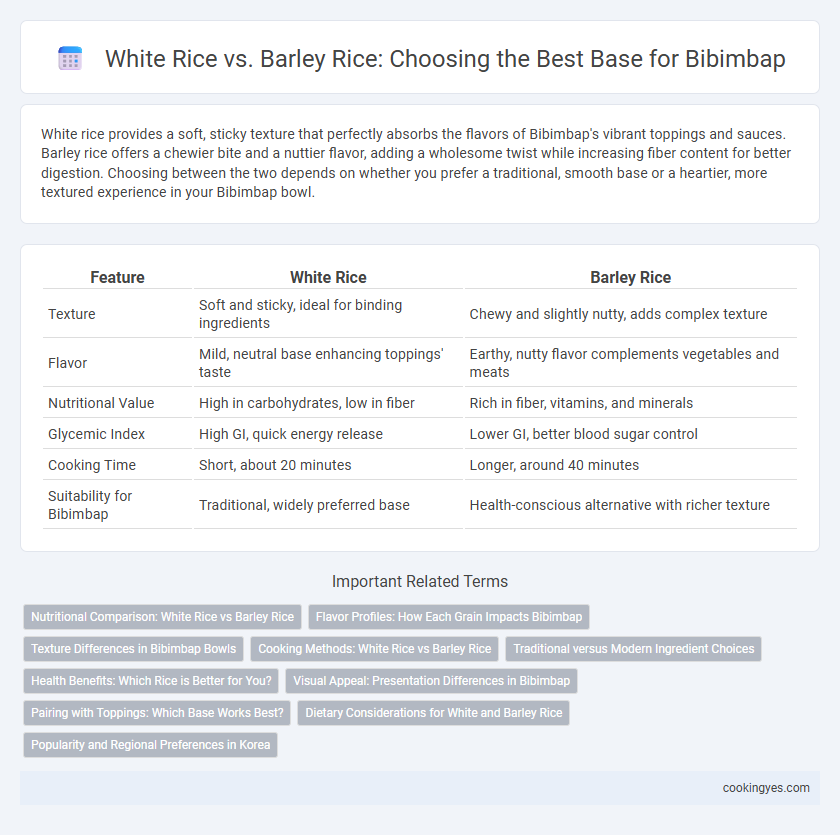White rice provides a soft, sticky texture that perfectly absorbs the flavors of Bibimbap's vibrant toppings and sauces. Barley rice offers a chewier bite and a nuttier flavor, adding a wholesome twist while increasing fiber content for better digestion. Choosing between the two depends on whether you prefer a traditional, smooth base or a heartier, more textured experience in your Bibimbap bowl.
Table of Comparison
| Feature | White Rice | Barley Rice |
|---|---|---|
| Texture | Soft and sticky, ideal for binding ingredients | Chewy and slightly nutty, adds complex texture |
| Flavor | Mild, neutral base enhancing toppings' taste | Earthy, nutty flavor complements vegetables and meats |
| Nutritional Value | High in carbohydrates, low in fiber | Rich in fiber, vitamins, and minerals |
| Glycemic Index | High GI, quick energy release | Lower GI, better blood sugar control |
| Cooking Time | Short, about 20 minutes | Longer, around 40 minutes |
| Suitability for Bibimbap | Traditional, widely preferred base | Health-conscious alternative with richer texture |
Nutritional Comparison: White Rice vs Barley Rice
White rice, commonly used in bibimbap, offers a soft texture and higher carbohydrate content, providing quick energy but lower fiber levels. Barley rice, rich in dietary fiber, vitamins, and minerals such as magnesium and selenium, supports better digestion and sustained energy release. Opting for barley rice enhances the nutritional profile of bibimbap with increased antioxidants and reduced glycemic index compared to white rice.
Flavor Profiles: How Each Grain Impacts Bibimbap
White rice offers a neutral, slightly sweet flavor that highlights the vibrant ingredients and bold seasonings in bibimbap, creating a harmonious balance. Barley rice provides a nutty, earthy taste with a chewy texture, adding depth and complexity to the dish's overall flavor profile. Choosing between white and barley rice influences bibimbap's taste experience, with white rice enhancing freshness and barley rice emphasizing heartiness.
Texture Differences in Bibimbap Bowls
White rice offers a soft and sticky texture that clings well to the toppings in Bibimbap, creating a cohesive bite with each spoonful. Barley rice introduces a chewier, nuttier grain texture that adds a satisfying contrast and depth to the dish's overall mouthfeel. Choosing between white and barley rice as the base significantly influences the sensory experience, balancing smoothness against heartiness in traditional Bibimbap bowls.
Cooking Methods: White Rice vs Barley Rice
White rice for Bibimbap is typically cooked using the absorption method, resulting in a soft and sticky texture that binds well with the mixed vegetables and sauce. Barley rice requires longer soaking and simmering time due to its tougher grains, producing a chewier texture and nutty flavor that adds depth to the dish. Stirring and resting are crucial for both, but barley rice benefits from extended cooking to fully soften the fibrous bran layer without becoming mushy.
Traditional versus Modern Ingredient Choices
Traditional bibimbap predominantly uses white rice, prized for its soft texture and neutral flavor that complements the vibrant toppings. Modern variations increasingly incorporate barley rice, valued for its nutty taste, higher fiber content, and added health benefits. The choice between white rice and barley rice reflects a balance between preserving authentic culinary heritage and embracing nutritional innovation in contemporary Korean cuisine.
Health Benefits: Which Rice is Better for You?
White rice provides a soft texture and neutral flavor that highlights Bibimbap's vibrant ingredients but has a higher glycemic index, potentially causing quicker blood sugar spikes. Barley rice offers more fiber, vitamins, and minerals, supporting better digestion and sustained energy release beneficial for overall health. Choosing barley rice as a Bibimbap base enhances its nutritional profile with increased antioxidants and heart-healthy properties compared to traditional white rice.
Visual Appeal: Presentation Differences in Bibimbap
White rice provides a clean, bright base for bibimbap, enhancing the dish's vivid vegetable colors and making the presentation visually striking. Barley rice, with its slightly darker and textured appearance, adds a rustic and hearty look that contrasts well with the vibrant toppings but may visually blend with earth-toned ingredients. The choice between white and barley rice impacts bibimbap's aesthetic balance, with white rice emphasizing crispness and barley rice contributing a natural, wholesome presentation.
Pairing with Toppings: Which Base Works Best?
White rice offers a neutral, sticky texture that perfectly absorbs and complements the bold, spicy, and savory toppings common in bibimbap, enhancing the harmony of flavors. Barley rice introduces a nuttier taste and chewier texture, which adds a contrasting dimension but can compete with delicate toppings like raw vegetables or mild mushrooms. For traditional bibimbap balance, white rice remains the optimal base, providing a smooth canvas that highlights the complexity of ingredients such as gochujang, sauteed spinach, and seasoned beef.
Dietary Considerations for White and Barley Rice
White rice is a common base for bibimbap, offering a soft texture and mild flavor that pairs well with diverse toppings, but it has a higher glycemic index which may affect blood sugar levels. Barley rice provides more dietary fiber and nutrients like beta-glucan, supporting digestive health and sustained energy release, making it a better choice for those seeking improved cholesterol regulation and blood sugar control. Choosing between white and barley rice depends on individual dietary needs, such as prioritizing fiber intake or managing glucose levels for optimal health benefits in bibimbap.
Popularity and Regional Preferences in Korea
White rice remains the most popular base for bibimbap across Korea due to its soft texture and mild flavor that complements the dish's diverse ingredients. Barley rice, favored in certain regions like Jeolla and Gangwon, offers a nuttier taste and higher fiber content, appealing to health-conscious consumers. Regional preferences reflect cultural traditions and local agricultural practices influencing the choice between white and barley rice in bibimbap preparation.
White Rice vs Barley Rice for Bibimbap base Infographic

 cookingyes.com
cookingyes.com